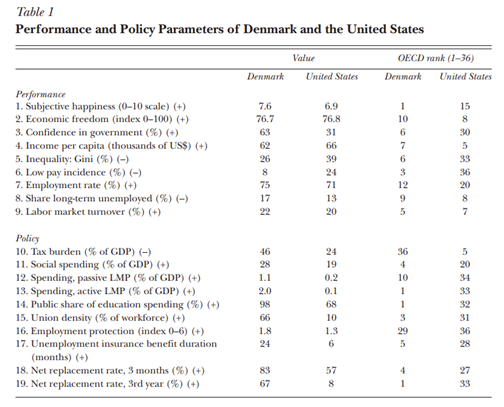Essay about Danish Flexicurity: Rights and Duties
One of the worlds’ smallest countries, Denmark, is also one of the richest countries measured on income per capita – and this even with low inequality, low unemployment, and high-income security. What is the key?

It is often argued that the predominant reason for this performance is the Danish labor market model, known as ‘flexicurity’, that is, flexible hiring and firing with an underlying “right and duty” principle where the unemployed has a right to receive income support and public assistance in finding a new job. It is, however, also the unemployed’ s duty to search actively for jobs and take up appropriate work.
The flexicurity policy needs to include comprehensive active labor market programs, called ALMPs, with compulsory participation for recipients of unemployment compensation. Along with Denmark's relatively equal wealth thus follows considerable spending on labor market programs – in fact, Denmark spends more on active labor market programs than any other OECD country.
In their essay Danish Flexicurity: Rights and Duties professors Claus Thustrup Kreiner and Michael Svarer review empirical evidence on the effectiveness of ALMPs from the ongoing Danish policy evaluation and discuss the aptness of flexicurity to meet challenges from globalization, automation, and immigration. Why? Because, although these developments are likely beneficial for aggregate income, they may also pose an unwanted disruptive threat for employment – especially for the low-skilled workers.
Denmark, being a small and open economy and part of the EU’s free mobility of labor and capital and – along with many other countries - strongly affected by globalization and automation could potentially foresee negative effects on the labor market.
However, Table 1 shows that Denmark is doing well on measures of low unemployment and a relatively equal distribution of incomes.
 Following the content of Table 1, Claus and Michael write:
Following the content of Table 1, Claus and Michael write:
“For American readers, an obvious question is whether it is feasible and desirable for the United States to adopt its own version of Danish flexicurity. There are several difficult issues here.”
Among the issues to take into consideration are the heterogeneity of the population, the size of public spending on active labor market policy and education, the needed support for active market policy, and finally the social attitudes about fairness of outcomes.
